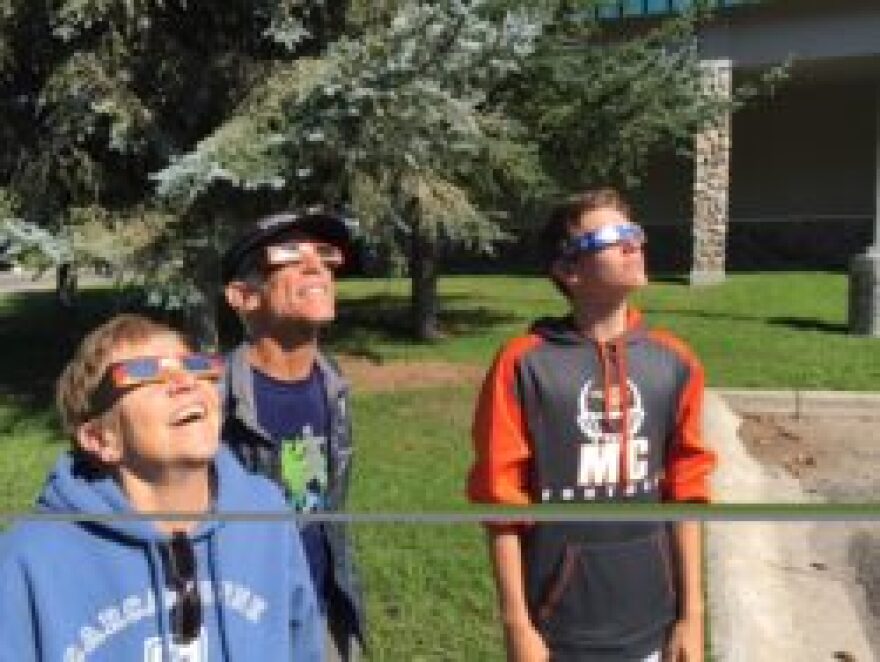When I looked up at the cloudy sky on October 14, I was dismayed. I was so looking forward to watching the partial solar eclipse, predicted to be at its height at 80% in Cache Valley at 10:15. Now the sun was hidden behind heavy clouds. Refusing to give up all hope, I slipped my eclipse glasses into my pocket and headed up a hiking trail on the Wellsville mountains. At 10:10 I stopped on an open ledge, put the glasses on, and looked up into the sky.
I saw nothing but absolute, total black.
I waited a few minutes. I put the glasses back on.
This time I saw the darkness thinning. And behold! A golden croissant appeared in the black sky.
In very slow motion, the moon continued to slide across this glowing crescent, reducing it to a thin golden semi-circle.
It was spellbinding for me because this partial eclipse was so different from the 3 total eclipses I’d already seen. This time my attention was on the big black moon rock sailing slowly across a spot of light. In the past, watching a total eclipse was all about the sun disappearing.
My first eclipse was in 1961. My high school physics teacher had taken us on an all-night bus ride. In the morning, the bus pulled over in an olive grove. I will never forget how the color drained out of the countryside. The birds stopped singing. We felt the chill as the temperature dropped.
My second total eclipse was on a ship in the middle of the Atlantic Ocean. We were on course to intercept the path of totality when it started raining. The shop’s captain gunned the engines and somehow found a bit of open sky. We counted down: 3,2,1, Zero! The sun disappeared and the stars came out. We took off our glasses. We held our breath. And then a tiny spot of hot sun poked out on the the sun’s aurora, and what looked like a giant engagement ring spread across the sky.
My third eclipse was near the Grand Tetons in 2017. This time I was fascinated by the small crescents of sunlight shadows dancing across my shoes.
In ancient times, the temporary extinguishing of the sun caused quite a bit of fear. The Chinese thought a giant dragon was taking bites out of the sun. They beat drums to drive the dragon away. In other countries, warriors shot flaming arrows into the sky to reignite the lost fireball.
We still have much to learn about the moon, the sun, the stars, and beyond. But what I learned this year was that the sun is 400 times the size of the moon. The moon is 390 times closer to the earth. This allows the sun and moon to appear to us to be the about same size. So, when the moon slides between us and the sun, sometimes it covers it completely. But when the moon is at its farthest from the earth, it leaves the fiery edges of the sun exposed – the Ring of Fire.
It’s a math problem with moving parts, but mathematicians can predict exactly when the next total eclipse will be visible in North America.
Set your calendar for April 8, 2024.
This is Mary Heers and I’m Wild About Utah.
Credits:
Photos: Courtesy & Copyright Mary Heers. T-shirt image © 2012 Betchart Expeditions Inc.
Featured Audio: Courtesy & Copyright © Friend Weller, Utah Public Radio upr.org
Text: Mary Heers, https://cca.usu.edu/files/awards/art-and-mary-heers-citation.pdf
Additional Reading: Lyle Bingham, https://bridgerlandaudubon.org/
Additional Reading
Wild About Utah, Mary Heers’ Postings
“Some Tribes are allowed to view the eclipse while others, like the Navajo and Ute Indian Tribes, do not look at it. This can include reflections (water, mirrors, windows, etc.) or photos.
Please avoid posting videos or photos of the eclipse on social media – some Tribes are forbidden to look at the eclipse, including images and videos…”
2023 Annular Eclipse, San Juan County Economic Visitor Services, https://www.utahscanyoncountry.com/2023_annular_eclipse
Strand, Holly, Ring of Fire, Wild About Utah, May 17, 2012, https://wildaboututah.org/ring-of-fire/
Eclipses, NASA, https://science.nasa.gov/eclipses/
2023 Solar Eclipse, NASA, https://science.nasa.gov/eclipses/future-eclipses/eclipse-2023/
[Future Eclipses] April 8, 2024, Solar Eclipse, NASA, https://science.nasa.gov/eclipses/future-eclipses/eclipse-2024/
2023 Annual Eclipse, Bryce Canyon National Park, National Park Service, US Department of the Interior, https://www.nps.gov/brca/planyourvisit/2023-annular-eclipse.htm
Annular Solar Eclipse, October 14, 2023, Capital Reef National Park, National Park Service, US Department of the Interior, https://www.nps.gov/care/planyourvisit/annular-solar-eclipse.htm
Atlantic Crossing Total Eclipse 2013, Betchart Expeditions Inc.,
Webpage: https://www.solareclipsetrips.com/europe_atlantic2013.htm
Mailer: https://www.solareclipsetrips.com/pdf_files/atlantic_cros_final_1300_01x.pdf




